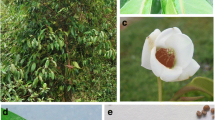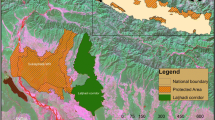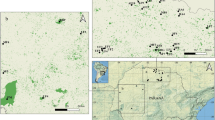Abstract
Species abundance and habitat distribution are two important aspects of species conservation studies and both are affected by similar environmental factors. Forest resource inventory data in 2010 were used to evaluate the patterns of habitat for target species of Cervidae in six typical forestry bureaus of the Yichun forest area in the Lesser Xing’an Mountains, northeastern China. A habitat suitability index (HSI) model was used based on elevation, slope, aspect, vegetation and age of tree. These five environmental factors were selected by boosted regression tree (BRT) analysis from 14 environmental variables collected during field surveys. Changes in habitat caused by anthropogenic activities mainly involving settlement and road factors were also considered. The results identified 1780.49 km2 of most-suitable and 1770.70 km2 of unsuitable habitat areas under natural conditions, covering 16.38% and 16.29% of the entire study area, respectively. The area of most-suitable habitat had been reduced by 4.86% when human interference was taken into account, whereas the unsuitable habitat area had increased by 11.3%, indicating that anthropogenic disturbance turned some potential habitats into unsuitable ones. Landscape metrics indicated that average patch area declined while patch density and edge density increased. This suggests that as habitat becomes fragmented and its quality becomes degraded by human activities, cervid populations will be threatened with extirpation. The study helped identify the spatial extent of habitat influenced by anthropogenic interference for the local cervid population. As cervid species clearly avoid human activities, more attention should be paid on considering the way and intensity of human activities for habitat management as fully as possible
Similar content being viewed by others
References
Anwar T, Saixun Y, Mahmut H, 2008. Habitat suitability assessment on the Tarim subspecies of red deer (Cervus elaphus yarkandensis) in the lower reaches of Cherchen River, Xinjiang, China. Journal of Arid Land Resources and Environment, 22(11): 196–200. (in Chinese)
Bonnot N, Morellet N, Verheyden H et al., 2013. Habitat use under predation risk: Hunting, roads and human dwellings influence the spatial behaviour of roe deer. European Journal of Wildlife Research, 59(2): 185–193.
Bowman J, Robitaille J F, 2005. An assessment of expert-based marten habitat models used for forest management in Ontario. Forestry Chronicle, 81(6): 801–807.
Brehme C S, Tracey J A, McClenaghan L R et al., 2013. Permeability of roads to movement of scrubland lizards and small mammals. Conservation Biology, 27(4): 710–720.
Cao M C, Liu G H, 2008. Habitat suitability change of red-crowned crane in Yellow River Delta Nature Reserve. Journal of Forestry Research, 19(2): 141–147.
Couturier T, Besnard A, Bertolero A et al., 2014. Factors determining the abundance and occurrence of Hermann’s tortoise Testudo hermanni in France and Spain: Fire regime and landscape changes as the main drivers. Biological Conservation, 170: 177–187.
Dettki H, Lofstrand R, Edenius L, 2003. Modeling habitat suitability for moose in coastal northern Sweden: Empirical vs process-oriented approaches. Ambio, 32(8): 549–556.
Dou H L, Jiang G S, Stott P et al., 2013. Climate change impacts population dynamics and distribution shift of moose (Alces alces) in Heilongjiang Province of China. Ecological Research, 28: 625–632. (in Chinese)
Dussault C, Poulin M, Courtois R et al., 2006. Temporal and spatial distribution of moose-vehicle accidents in the Laurentides Wildlife Reserve, Quebec, Canada. Wildlife Biology, 12(4): 415–425.
Eigenbrod F, Hecnar S J, Fahrig L, 2008. Accessible habitat: An improved measure of the effects of habitat loss and roads on wildlife populations. Landscape Ecology, 23(2): 159–168.
Elith J, Leathwick J R, Hastie T, 2008. A working guide to boosted regression trees. Journal of Animal Ecology, 77(4): 802–813.
Forman R T T, Alexander L E, 1998. Roads and their major ecological effects. Annual Review of Ecology and Systematica, 29: 207–231.
Garcia-Aguirre M C, Ortiz M A, Zamorano J J et al., 2007. Vegetation and landform relationships at Ajusco volcano Mexico, using a geographic information system (GIS). Forest Ecology and Management, 239(1–3): 1–12.
Hemami M R, Watkinson A R, Dolman P M, 2004. Habitat selection by sympatric muntjac (Muntiacus reevesi) and roe deer (Capreolus capreolus) in a lowland commercial pine forest. Forest Ecology and Management, 194(1–3): 49–60.
Houle M, Fortin D, Dussault C et al., 2010. Cumulative effects of forestry on habitat use by gray wolf (Canis lupus) in the boreal forest. Landscape Ecology, 25(3): 419–433.
Jiang G S, 2007. Ecological effects of human disturbances on moose and roe deer and their adaptation meehanisms at multiple spatial scale [D]. Harbin: Northeast Forestry University. (in Chinese)
Jiang G S, Zhang M H, Ma J Z, 2005. The fragmentation and impact factors of red deer habitat in Wandashan region, Heilongjiang Province, China. Acta Ecologica Sinica, 25(7): 1691–1698. (in Chinese)
Jin L R, He H S, Zong C et al., 2008. Effects of different forest management alternatives on Sciurus vulgaris habitat. Chinese Journal of Applied Ecology, 19(5): 949–955. (in Chinese)
Jorge M, Galetti M, Ribeiro M C et al., 2013. Mammal defaunation as surrogate of trophic cascades in hotspot. Biological Conservation, 163: 49–57.
Ko D W, He H S, Larsen D R, 2006. Simulating private land ownership fragmentation in the Missouri Ozarks, USA. Landscape Ecology, 21(5): 671–686.
Larson M A, Thompson F R, Millspaugh J J et al., 2004. Linking population viability, habitat suitability, and landscape simulation models for conservation planning. Ecological Modelling, 180(1): 103–118.
Li J, Li Y, Miao L et al., 2014. Habitat assessment of sika deer (Cervus nippon) in the Taohongling National Nature Reserve, Jiangxi Province, China. Acta Ecologica Sinica, 34(5): 1274–1283. (in Chinese)
Li Y H, Wu W, Li N N et al., 2013. Effects of forest ownership regime on landscape pattern and animal habitat: A review. The Journal of Applied Ecology, 24(7): 2056–2062. (in Chinese)
Lofman S, 2007. Long-term changes in two boreal landscapes with different management histories. Scandinavian Journal of Forest Research, 22(1): 22–32.
Martin J, Revilla E, Quenette P Y et al., 2012. Brown bear habitat suitability in the Pyrenees: Transferability across sites and linking scales to make the most of scarce data. Journal of Applied Ecology, 49(3): 621–631.
McGarigal K, Cushman S A, 2002. Comparative evaluation of experimental approaches to the study of habitat fragmentation effects. Ecological Applications, 12(2): 335–345.
Mcshea W J, 2012. Ecology and management of white-tailed deer in a changing world. Year in Ecology and Conservation Biology, 1249: 45–56.
Menard N, Rantier Y, Foulquier A et al., 2014. Impact of human pressure and forest fragmentation on the endangered Barbary macaque Macaca sylvanus in the Middle Atlas of Morocco. Oryx, 48(2): 276–284.
Miranda B R, Porter W F, 2003. Statewide habitat assessment for white-tailed deer in Arkansas using satellite imagery. Wildlife Society Bulletin, 31(3): 715–726.
Ohashi H, Yoshikawa M, Oono K et al., 2014. The impact of sika deer on vegetation in Japan: Setting management priorities on a national scale. Environmental Management, 54(3): 631–640.
O’Hara K L, Ramage B S, 2013. Silviculture in an uncertain world: Utilizing multi-aged management systems to integrate disturbance. Forestry, 86(4): 401–410.
Ossi F, Gaillard J M, Hebblewhite M et al., 2015. Snow sinking depth and forest canopy drive winter resource selection more than supplemental feeding in an alpine population of roe deer. European Journal of Wildlife Research, 61(1): 111–124.
Ottaviani D, Lasinio G J, Boitani L, 2004. Two statistical methods to validate habitat suitability models using presence-only data. Ecological Modelling, 179(4): 417–443.
Parks S A, Harcourt A H, 2002. Reserve size, local human density, and mammalian extinctions in US protected areas. Conservation Biology, 16(3): 800–808.
Paudel P K, Hais M, Kindlmann P, 2015. Habitat suitability models of mountain ungulates: Identifying potential areas for conservation. Zoological Studies, 54: 37.
Pekin B K, Pijanowski B C, 2012. Global land use intensity and the endangerment status of mammal species. Diversity and Distributions, 18(9): 909–918.
Piao R Z, Guan G S, Zang M H, 1995. The research of moose population and distribution status in China. Scientia Silvae Sinicae, 15(1): 11–16. (in Chinese)
Piekielek N B, Hansen A J, 2012. Extent of fragmentation of coarse-scale habitats in and around US national parks. Biological Conservation, 155: 13–22.
Qin Y, Nyhus P J, Larson C L et al., 2015. An assessment of South China tiger reintroduction potential in Hupingshan and Houhe National Nature Reserves, China. Biological Conservation, 182: 72–86.
R Development Core Team (RDCT), 2011. R: A Language and Environment for Statistical Computing. R Foundation for Statistical Computing.
Ray N, Burgman M A, 2006. Subjective uncertainties in habitat suitability maps. Ecological Modelling, 195(3/4): 172–186.
Reimoser S, Partl E, Reimoser F et al., 2009. Roe-deer habitat suitability and predisposition of forest to browsing damage in its dependence on forest growth: Model sensitivity in an alpine forest region. Ecological Modelling, 220(18): 2231–2243.
Rempel R S, Elkie P C, Rodgers A R et al., 1997. Timber-management and natural-disturbance effects on moose habitat: Landscape evaluation. Journal of Wildlife Management, 61(2): 517–524.
Robel R J, Fox L B, Kemp K E, 1993. Relationship between habitat suitability index values and ground counts of beaver colonies in Kansas. Wildlife Society Bulletin, 21(4): 415–421.
Rodriguez A, Delibes M, 2003. Population fragmentation and extinction in the Iberian lynx. Biological Conservation, 109(3): 321–331.
Shen C Z, Jia J B, 2006. Winter habitat selection by moose in Shengshan, Heihe, the Lesser Khingan Mountain. Sichun Journal of Zoology, 25(1): 40–45. (in Chinese)
Sanchez-Azofeifa G A, Kachmar M, Kalacska M et al., 2003. Experiences in field data collection: In support of land use and land cover change classification in boreal and tropical environments. In: Remote Sensing of Forest Environments: Concepts and Case Studies: 433–446. Dordrecht, Netherlands: Springer.
Shifley S R, Thompson F R, Dijak W D et al., 2006. Simulated effects of forest management alternatives on landscape structure and habitat suitability in the Midwestern United States. Forest Ecology and Management, 229(1–3): 361–377.
Smith D F, Litvaitis J A, 2000. Foraging strategies of sympatric lagomorphs: Implications for differential success in fragmented landscapes. Canadian Journal of Zoology—Revue Canadienne De Zoologie, 78(12): 2134–2141.
Stehman S V, Salzer D W, 2000. Estimating density from surveys employing unequal-area belt transects. Wetlands, 20(3): 512–519.
Taylor B D, Goldingay R L, 2010. Roads and wildlife: Impacts, mitigation and implications for wildlife management in Australia. Wildlife Research, 37(4): 320–331.
Thomas L, Buckland S T, Rexstad E A et al., 2010. Distance software: Design and analysis of distance sampling surveys for estimating population size. Journal of Applied Ecology, 47(1): 5–14.
Trombulak S C, Frissell C A, 2000. Review of ecological effects of roads on terrestrial and aquatic communities. Conservation Biology, 14(1): 18–30.
Van der Lee G E M, Van der Molen D T, Van den Boogaard H F P et al., 2006. Uncertainty analysis of a spatial habitat suitability model and implications for ecological management of water bodies. Landscape Ecology, 21(7): 1019–1032.
Waltert M, Meyer B, Shanyangi M W et al., 2008. Foot surveys of large mammals in woodlands of western Tanzania. Journal of Wildlife Management, 72(3): 603–610.
Wilson J W, Sexton J O, Jobe R T et al., 2013. The relative contribution of terrain, land cover, and vegetation structure indices to species distribution models. Biological Conservation, 164(8): 170–176.
Wu W, Li Y H, Hu Y M, 2016a. Simulation of potential habitat overlap between red deer (Cervus elaphus) and roe deer (Capreolus capreolus) in northeastern China. PeerJ 4: e1756.
Wu W, Li Y H, Hu Y M et al., 2016b. Plants diversity and vegetation structure in the understory of mixed boreal forests under different management regimes in northeastern China. Polish Journal of Environmental Studies, 25(4): 1749–1757.
Wu W, Li Y H, Hu Y M et al., 2016c. Suitable winter habitat for Cervus elaphus on the southern slope of the Lesser Xingan Mountains. Biodiversity Science, 24(1): 20–29. (in Chinese)
Wu W, Li Y H, Hu Y M et al., 2018. Impacts of changing forest management areas on forest landscapes and habitat patterns in northeastern China. Sustainability, 10: 1211.
Xie F J, Li X Z, Xiao D N et al., 2006. Post-fire habitat restoration of sables during winter season in northern slope of the Great Xing’an Mountains. Journal of Forestry Research, 17(3): 231–237.
Zeng H, Sui D Z, Wu X B, 2005. Human disturbances on landscapes in protectedareas: A case study of the Wolong Nature Reserve. Ecological Research, 20(4): 487–496.
Zhang Y, Lei K, Zhang Y et al., 2012. Effects of vegetation, elevation and human disturbance on the distribution of large- and medium-sized wildlife: A case study in Jiuzhaigou Nature Reserve. Acta Ecologica Sinica, 32(13): 4228–4235. (in Chinese)
Zhang Y, Zhang M H, 2010. Evaluation system with FAHP of deer habitat in northeast China. Chinese Journal of Wildlife, 31(1): 42–44. (in Chinese)
Acknowledgments
We thank all the members of the landscape ecology group of the Institute of Applied Ecology, Chinese Academy of Sciences, for assistance with the fieldwork.
Author information
Authors and Affiliations
Corresponding author
Additional information
Foundation: National Natural Science Foundation of China, No.41871197, No.41271201; The Doctoral Scientific Research Foundation of Liaoning Province, No. 20170520280; The Fundamental Research Funds for the Central Universities of China, No. N171104003
Author: Wu Wen, PhD, specialized in landscape ecology.
Rights and permissions
About this article
Cite this article
Wu, W., Li, Y., Hu, Y. et al. Anthropogenic effect on forest landscape pattern and Cervidae habitats in northeastern China. J. Geogr. Sci. 29, 1098–1112 (2019). https://doi.org/10.1007/s11442-019-1647-5
Received:
Accepted:
Published:
Issue Date:
DOI: https://doi.org/10.1007/s11442-019-1647-5




